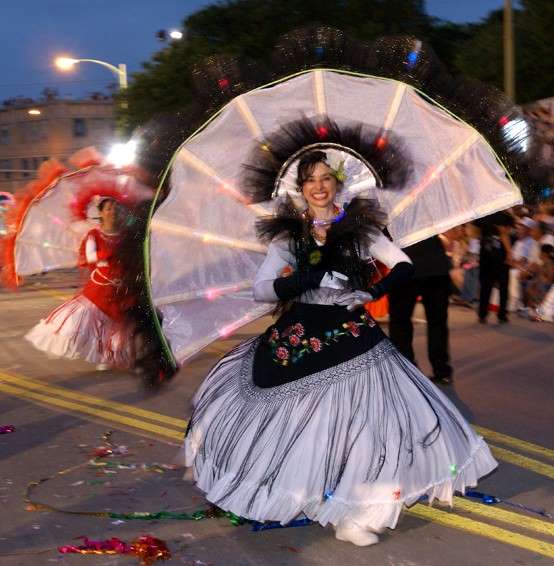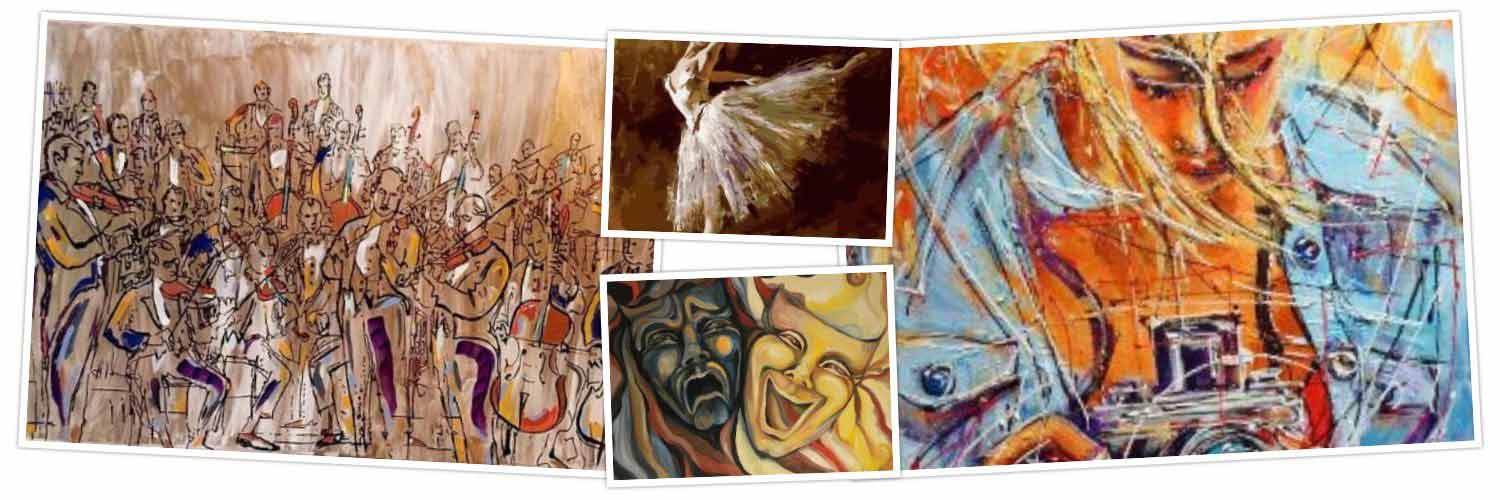Catherine Cisneros, Artistic Director, URBAN-15
By JASMINA WELLINGHOFF, Editor
URBAN-15 has a number of programs and events in different disciplines. How would you describe the organization and its activities?
We have three disciplines that we espouse: music, movement (dance, etc.) and media. Actually, we have one more that we do not talk about that much, and that’s design – costuming and sets. All of us are multidisciplinary artists; so, we play music, we dance and we work in film and photography, too. And everyone has at least two specialties.

Which ones are yours?
Number one, I am a visual artist, a sculptor; I work in 3-D. That’s what I excel in, making things. My second discipline is dance, including choreography. And my third one is music. I play percussion. Everyone here ends up playing percussion at some point.
Please list URBAN-15’s programs?
In music, we have a professional percussion ensemble, and a senior-adult ensemble that also performs for the public. In dance, we have the Carnaval de San Anto which performs in parades and city events. In media, we have the holiday laser show, one for children and one for the general public. And then, we have film festivals. The Josiah Media Festival has grown to be an international fest for young filmmakers, 21 and younger. It’s a competition, there are winners, we give prizes and we broadcast it. It started as a local event but it kept growing, and now it’s international. The quality of the submissions is amazing.
As for the other film fest, The Manhattan Short, that happened through happenstance. We are just a venue for them. They were looking for a place to host their festival in this region, and we said “sure!” It has been quite interesting to be a part of it. (The Manhattan Short is unique. The final selections screen simultaneously in different cities across the world for a week where attendees vote for Best Film and Best Actor Awards at each venue.)
Oh! And we have one more festival, a poetry festival, Mega Corazon, which is April during National Poetry Month. Last year, everything was done remotely. The poets recorded themselves in their homes and sent the videos to us. Jonathan Anderson, who is the project manager for Josiah Media Festival, put it all together. This year we are trying to do in the studio. We’ll bring each poet by themselves and videotape them here. Here we have the proper lighting and really good sound. It’s such a good festival. We are so proud of it. (Scheduled for April 5, 2021; will be broadcast throughout the month of April.)
How has the pandemic affected you?
Everything is online; all rehearsals are online, as well. But we just started meeting with the drummers at San Pedro Park to practice together. We are so hungry to practice together. Yet I don’t think it will work for the dance ensemble. We are too close together; we breathe on each other. I want to wait a little longer until everybody has been vaccinated.
How did Carnaval de San Anto start?
The Fiesta Flambeau Parade Association asked us to help them. So, the first thing we did was to issue an open call to artists to participate in our parade project, and all our friends came. We were all trained dancers and musicians. I costumed all, and we got onto the street and there was a screaming standing ovation. For about three miles, all spectators were on their feet, screaming. They had never seen anything like that. From there, we got hooked; it’s hard to turn your back on a standing ovation. Among the dancers were folkloric dancers, flamenco dancers, jazz dancers, tap, modern… it turned into this really amazing ensemble.
What are some personal goals you are working on now?
We are doing the global Water Dances this year again. It’s an international event (to highlight the need for safe water and water preservation). We’ll be performing at the San Pedro Creek Culture Park by the waterfall, near the Italian Church. It’s so beautiful there. Two years ago, when we took part in this event for the first time, there were 130 sites across the continents where dancers performed on the same day. We all did the same choreography first, followed by our own. I am developing the choreography for this year’s Water Dances at present. (Performance takes place June 8.)
In one of your emails to me you indicated that there was something you wanted to discuss during this interview. What’s on your mind?
As the elder member of the arts community, I have come to realize that artists are a tribe. We have different bodies, ethnicities and abilities but in a room of people, I can tell who the artists are. It’s just something in the soul and it just sparks. Artist recognize artists. This country, this culture expands energy and resources on athletes, on scientists. But the artists… they are discouraged from becoming artists because there’s no way to make a living. Now (raising her voice) what does the U.S. export? Culture! The entire world follows our music, our dance, film. It’s a huge export. So how come arts are not valued, not supported in the schools?
Speaking of support, how does URBAN-15 make money since so many of your events are free?
It’s a lot of grant application writing! We used to earn income through ticketed performances here, at the studio. We can’t do that anymore due to COVID, so it’s all from grants. We are keeping our heads above water! It was terrifying at first last March-April, and then, to make it worse, the city cut the funding for the arts. I thought we were going to lose everything. We have cut back on so much but we are keeping the doors open.
Let’s switch gears a bit. How did you meet your husband? (musician/composer George Cisneros who is URBAN-15’s Music and Media Director)
In high school. It was love at first sight.
Do you have children?
Yes, a son, Antonio Cisneros. He’s a cinematographer based in L.A. He’s been traveling the world, shooting in Iraq, in Europe, in Asia. Right now, he’s in El Paso shooting a documentary about the massacre that happened there. He’s brilliant. Interestingly enough, film is considered an essential industry in L.A., so they are vaccinating filmmakers (laughs).
Are you involved in any city-wide organizations or initiatives?
We have been part of the Westside Arts Coalition for 25 years. It consists of eight organizations. Our work is usually on the streets, murals, performances, events. We are the grassroots of the culture of the city. For 25 years we’ve been advocating for equity in funding from the city, and it has finally started happening. When it comes to city funding, the formula for funding has more to do with the size of your budget than with the value that you give to the community. So, it has been a struggle to bring wisdom into the formula.
San Antonio has a lively and diverse arts scene.
It has a very rich culture. I feel so happy to be here surrounded by this bubbling creativity.
Are you a native San Antonian?
That’s a long story. This city has always been a military town. After WWII, this place became such a military town, G.I.s were all over downtown. These young soldiers met and fell in love with all the beautiful San Antonio women. Suddenly you had these cross-cultural families! And that’s what happened to my family. As a military family, we lived overseas in Japan and Germany, and all over the United States. I was born in Japan. There were eight of us born in eight different places (chuckles). But San Antonio was home.
What’s the best advice your parents gave you?
It’s not exactly advice but here’s something our mother taught us. She taught us to share. It’s difficult to teach a child to share. We didn’t have much, so if we had a stick of gum, we had to cut it into eight parts. Sharing is kindness, it is community, and that’s why I started Carnaval de San Anto: to share.
What advice would you give to people?
We need to talk! That’s my advice. We need to learn how to speak with each other, which means we need to listen. And that’s not what I see happening. We don’t seem to be listening to each other. For the most part, we, women, have the ability to listen. With women becoming more powerful in the world, we may be able to help communication. We need conversation, even if it’s hard. If we keep speaking to each other, we can progress as humans.
If you could change one thing about yourself, what would it be?
I think I would like to be taller! (we both laugh).
You are related to the famous Henry Cisneros, our former mayor (and George’s brother). Tell us something about him that we don’t know.
He plays the piano very well. Music is a big part of his life. George and Henry are very close. In fact, George is at Henry’s house right now, helping with a project. It’s a very loving family.
What kind of gift would make you happy?
Books, fabrics and wind chimes.

Wonderful interview with Catherine Cisneros! Urban 15 brings so much light and joy and culture to the San Anto
community and to communities around the world. Brava!
Wow!! Well deserved interview, Cat! Your words are so very powerful. Bravo! Urban 15 is an awesome organization and I am very proud of you and George with your outstanding amazing creativity.